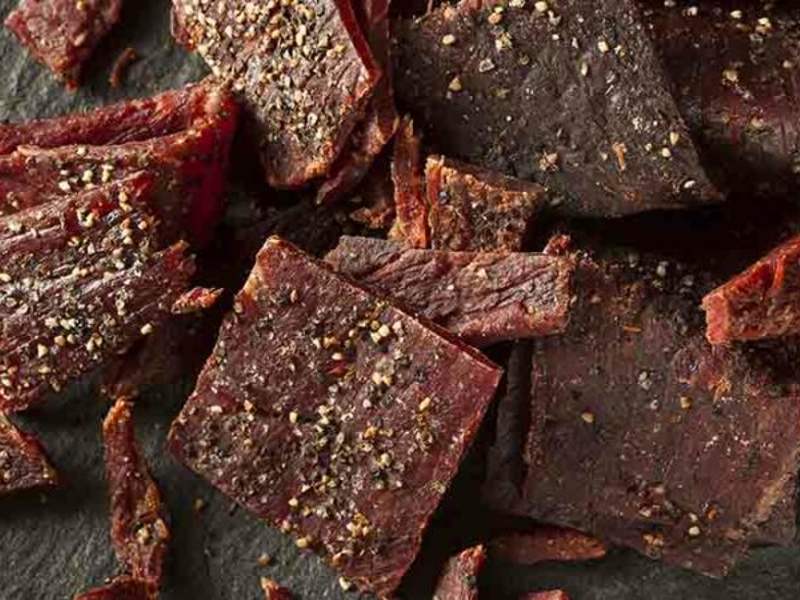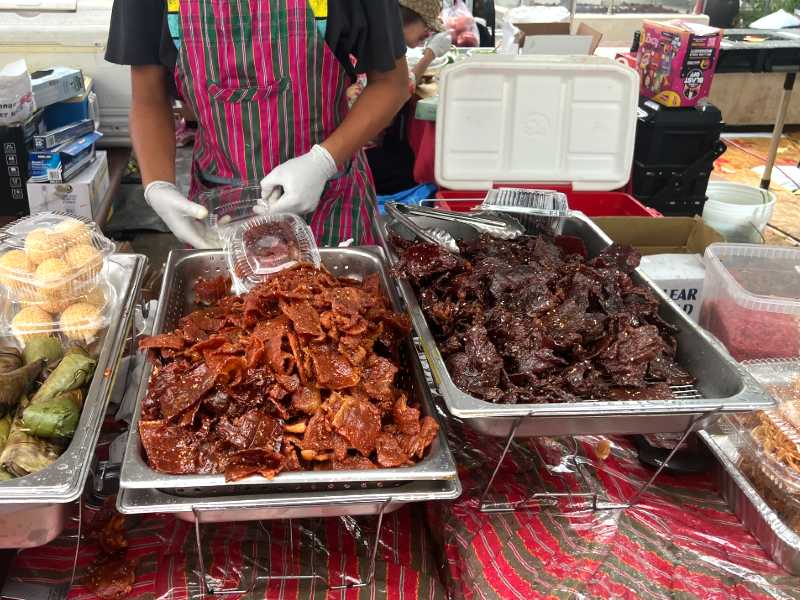Making — and eating — jerky is a workout for the senses.
Taste and smell are, of course, the most critical senses when making jerky.
But it’s also important to take note of what your jerky looks like. Its appearance will let you know what it’s been marinated with, when it’s done cooking… and whether or not it’s safe to eat.
Not sure what to look for when examining your jerky? Read on to learn what beef jerky should look like after it’s cooked — and what to do when it doesn’t look quite right.
Beef Jerky’s Appearance Before, During and After Cooking
How Should Beef Jerky Look Before It’s Cooked?
Beef changes in appearance quite a bit throughout the preparation process, and no two batches will look exactly the same.
But there are a few key characteristics that you should keep an eye out for.
Beef Color and Texture Before Cooking
Your beef should start out pinkish or light red in color. If you’ve chosen a lean cut of beef (which you definitely should!) it may have a very light marbling of fat or none at all.
The beef may have a brownish hue if it’s been stored in the refrigerator, and that’s fine as well. Beef oxidizes and turns brown after several days in the fridge, but the color change doesn’t affect its safety or taste.
However, any other color — gray, black, green — is a sign of spoilage, indicating that the beef should not be eaten.
You shouldn’t see any globs or strands of fat attached to the outside of the beef. If you do see any, you’ll need to remove them before doing anything else.
And you definitely shouldn’t see any fuzzy or slimy spots, specks, films or patches of any color on the beef — that’s mold or rot. You can’t safely remove these, so start over with a fresh cut of meat.
Beef Size and Shape Before Cooking
Connect with Real Jerky Makers
Because the Best Jerky Doesn't Come from a Store
Regardless of your beef’s original size and shape, you’ll need to slice it in order to make jerky.
Your beef slices don’t need to look uniform, and they don’t need to be a particular shape. Rectangular strips are the most common shape, but you’re free to cut circles, freeform shapes or any other form.
However, the slices do need to be between ⅛” and ¼” in thickness. If you’re new to making jerky, you may want to measure them at first to make sure they’re not too thick or thin, but you’ll quickly learn to eyeball it as you get more experience.
How Should Beef Jerky Look During Marination and Cooking?
Your jerky will change appearance multiple times during the cooking process.
The most dramatic changes begin during marination.
Dark marinade ingredients like soy sauce, Worcestershire sauce, BBQ sauce or red wine will, of course, make your jerky darker.
Brightly-hued spices can also change the meat’s color: paprika may add a reddish tinge to the beef, while turmeric can make it look a little golden.
If you added curing salt to your marinade, your beef may take on a pinker hue than it started with. This is due to the sodium nitrite in the curing salt and is perfectly normal, though you may not notice it if your marinade also contains darker ingredients.
Once your beef slices are in the dehydrator, smoker or oven, they’ll begin to shrink, shrivel and darken. As we’ll see in the next section, keeping an eye on these characteristics is key to telling when your jerky is done.
How Should Beef Jerky Look After It’s Cooked?
When your jerky is done dehydrating, it’ll have a dry, leathery appearance. Its wrinkled texture may resemble that of a raisin, or it may look a little smoother, like a well-worn leather glove.
Finished jerky should have a fairly matte finish. If the jerky has a greasy sheen to it, it needs to be cooked longer, as this indicates that excess moisture is still present.
Color-wise, cooked jerky is typically a dark reddish-brown, though it may look dark purple depending on the cut you used and your marinade ingredients.
However, it shouldn’t be so dark that you can’t discern any color — black jerky has been cooked too long and probably isn’t edible.
Your finished jerky may still have a fresh red hue if you used curing salt in your marinade. This is normal and a sign that the curing salt did its job — but if you didn’t use curing salt and your jerky is still a lighter red or pink, that’s a sign that it’s undercooked.
Beef Jerky Appearance Problems: Why Does My Jerky Look Like That?
Why Is My Beef Jerky Gray?
Uncooked, unmarinated beef should never look gray. Grayness is a sure sign that beef has gone bad and is likely harboring all kinds of nasty pathogens — the off-putting color is nature’s way of telling you not to eat this spoiled meat.
However, uncooked beef that’s been marinated may look just a little gray if you added table salt to the marinade. As long as it wasn’t gray before being marinated — and has been stored properly since — the gray color isn’t cause for concern.
Cooked beef jerky that’s turned gray, however, is a no-go. As with raw meat, grayness is a sign of spoilage, and the jerky should unfortunately be discarded.
Why Is My Beef Jerky Black?
Beef jerky can look very dark after marination and dehydration, but it shouldn’t be totally black.
If it is, that indicates that it’s been overdried or burned. It may have spent too long in the dehydrator, or parts of it may have come into contact with the ultra-hot sides of your oven or smoker.
It may technically be safe to eat, but it won’t taste very good — unless you like the flavor of burned meat!
Why Does My Beef Jerky Have Specks on It?
If you remove your beef jerky from the dehydrator and notice little specks that aren’t fuzzy or slimy, don’t worry. You’re probably just seeing tiny bits of seasoning from your marinade, as spices don’t always change color the same way beef does during dehydration.
Lighter-colored specks may be sesame seeds, onion powder, garlic powder or ginger powder. Brown or reddish specks may be cayenne pepper, red pepper flakes or paprika, while black specks are probably black pepper.
However, if you’ve stored your jerky for a while and notice specks that weren’t there before, your jerky has probably gone moldy and should be discarded.
Why Does My Beef Jerky Look Fuzzy?
Unfortunately, if your beef jerky looks fuzzy, it’s time to toss it. That fuzz is mold, and it’s virtually impossible to safely remove it from your jerky.
If any visible mold is present, there’s certainly even more growing that you can’t see. Assume that all jerky from that container is also contaminated and discard it as well — consuming moldy jerky can have serious health consequences that just aren’t worth the risk.
How Beef Jerky Is Made (Video)
"You might be a redneck if you think that beef jerky and moon pies are two of the major food groups."
-- Jeff Foxworthy





